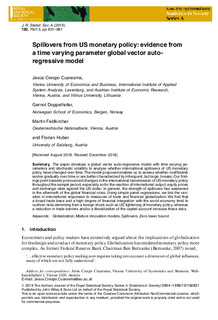| dc.contributor.author | Crespo Cuaresma, Jesus | |
| dc.contributor.author | Doppelhofer, Gernot Peter | |
| dc.contributor.author | Feldkircher, Martin | |
| dc.contributor.author | Huber, Florian | |
| dc.date.accessioned | 2019-06-07T06:35:56Z | |
| dc.date.available | 2019-06-07T06:35:56Z | |
| dc.date.created | 2019-05-22T10:52:13Z | |
| dc.date.issued | 2019 | |
| dc.identifier.citation | Journal of the Royal Statistical Society: Series A (Statistics in Society). 2019, 182 (3), 831-861. | nb_NO |
| dc.identifier.issn | 0964-1998 | |
| dc.identifier.uri | http://hdl.handle.net/11250/2600228 | |
| dc.description.abstract | The paper develops a global vector auto-regressive model with time varying parameters and stochastic volatility to analyse whether international spillovers of US monetary policy have changed over time. The model proposed enables us to assess whether coefficients
evolve gradually over time or are better characterized by infrequent, but large, breaks. Our findings point towards pronounced changes in the international transmission of US monetary policy throughout the sample period, especially so for the reaction of international output, equity prices
and exchange rates against the US dollar. In general, the strength of spillovers has weakened in the aftermath of the global financial crisis. Using simple panel regressions, we link the variation in international responses to measures of trade and financial globalization. We find that a broad trade base and a high degree of financial integration with the world economy tend to cushion risks stemming from a foreign shock such as US tightening of monetary policy, whereas a reduction in trade barriers and/or a liberalization of the capital account increase these risks | nb_NO |
| dc.language.iso | eng | nb_NO |
| dc.rights | Navngivelse 4.0 Internasjonal | * |
| dc.rights.uri | http://creativecommons.org/licenses/by/4.0/deed.no | * |
| dc.subject | globalization | nb_NO |
| dc.subject | mixture innovation models | nb_NO |
| dc.subject | spillovers | nb_NO |
| dc.subject | zero lower bound | nb_NO |
| dc.title | Spillovers from US monetary policy: evidence from a time varying parameter global vector auto-regressive model | nb_NO |
| dc.type | Journal article | nb_NO |
| dc.type | Peer reviewed | nb_NO |
| dc.description.version | publishedVersion | nb_NO |
| dc.subject.nsi | VDP::Mathematics and natural science: 400::Mathematics: 410 | nb_NO |
| dc.subject.nsi | VDP::Social science: 200::Economics: 210::Economics: 212 | nb_NO |
| dc.source.pagenumber | 831-861 | nb_NO |
| dc.source.volume | 182 | nb_NO |
| dc.source.journal | Journal of the Royal Statistical Society: Series A (Statistics in Society) | nb_NO |
| dc.source.issue | 3 | nb_NO |
| dc.identifier.doi | 10.1111/rssa.12439 | |
| dc.identifier.cristin | 1699414 | |
| cristin.unitcode | 191,30,0,0 | |
| cristin.unitname | Institutt for samfunnsøkonomi | |
| cristin.ispublished | true | |
| cristin.fulltext | original | |
| cristin.qualitycode | 1 | |

